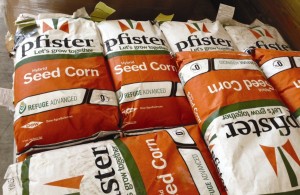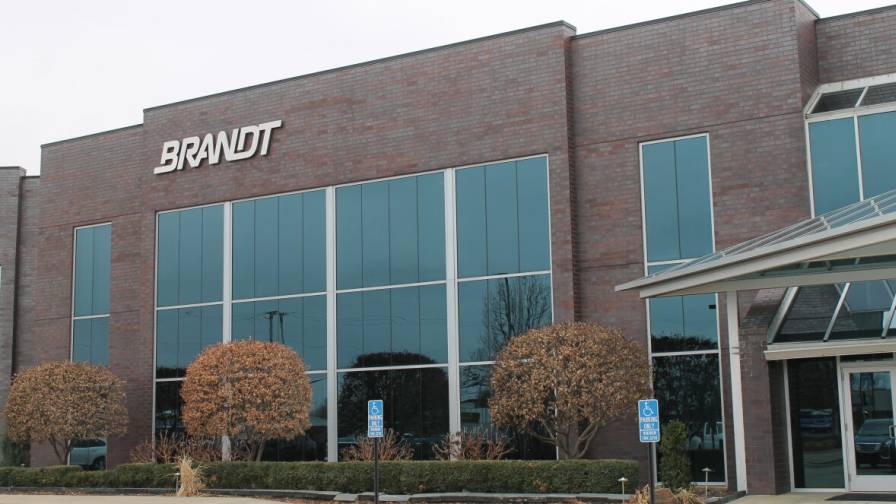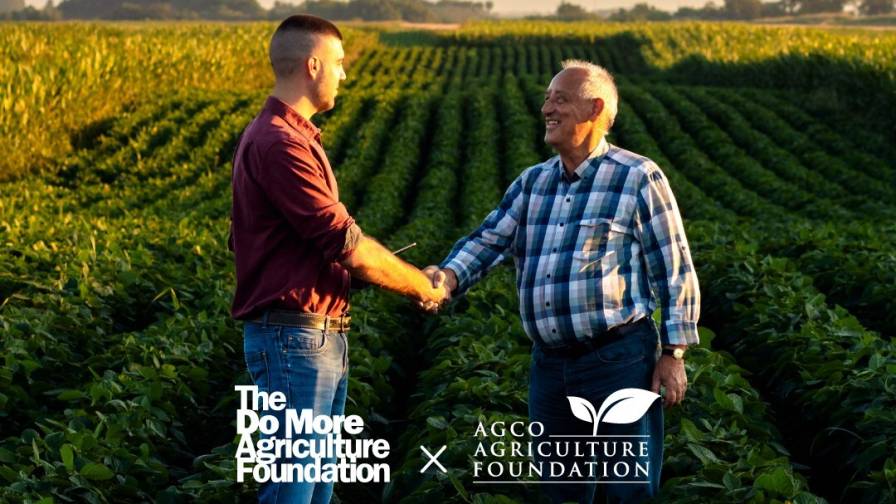Seed Still Central

Today’s varieties have huge yield potential, but they need the nutrition — delivered by retailers — to reach it.
The centrality of a grower’s choice of seed to his business cannot be understated. It now launches virtually all input-buying processes and determines cropping schedules.
But some would argue this heart-of-the-matter concept can be taken further, and with 20 years in the business, Dan Moehn, senior vice president for agronomy at Landmark Services Coop, Cottage Grove, WI, should know. He would call seed choice “the most emotional decision growers make all year long.”
In fact, Moehn adds that when he asks farmers what herbicide they used on a field, they’ll say, “whatever my salesperson recommended.” But when he asks what seed they used, they’ll name the exact variety and tell why they planted it.
Growers take into account many different variables when making a seed decision, says Gregg Johnson, agronomy manager at Reynolds United Coop, Reynolds, ND. His list would include commodity prices, land types, crop rotations, input variables and the costs associated with them. “If we can place the seed correctly, the right varieties show they can outyield other choices by three to seven bushels per acre,” he adds. Plus each variety can demonstrate incremental benefits in test weight, dry-down capability, ability to maintain structural integrity for better harvest stands, lower nitrogen use and drought resistance, where needed.
Feeding The Beast
To start, seed choice plays a huge role in fertility strategies and purchases. Today’s varieties have huge yield potential, but they need the nutrition — delivered by retailers — to reach it. “If we give them the food, it’s unbelievable how much these things will yield,” affirms Dan Carlson, seed sales manager with Reynolds United.
He notes that 2013-2014 fertility inputs have changed immensely, from even 2010 recommendations. Instead of putting on 400 to 500 pounds of dry fertilizer product on corn, growers want 600 to 700. Securing enough product to meet the demand can be a test. Volumes needed can stretch the supply chain to the limit, especially in delivering fertilizer to states such as North Dakota via rail or the Mississippi River. “This year there were times when we were out of nitrogen products regionally. Over a week to 10 days it was limited or not available, and a late planting made things worse. I saw Gregg’s department do everything they could just to get product in or out,” says Carlson. The challenge to get acres applied with fertilizer is formidable as well, he adds.
Another fertilizer must-have these days is micronutrients. The new hybrids need a number of these supplements to maximize yields, and industry has answered with a host of products from which to choose.
Pest Inputs
Along with fertilizer programs, insect control has also changed, based on the qualities a seed variety can bring to the table. Over the past decade many conventional insect spray programs — at least those aimed at worm pests — have given way to the suite of insecticide traits now contained in a wide array of products. Convenient and potent, the strategy has saved pesticide dollars.
But dealers and growers are finding they need to manage this technology more carefully these days due to developing corn pest resistance to Bt seed.
One example of a product that continues to evolve is the Herculex Insect Protection trait family. It’s the most widely used trait family in the corn market and a component of many trait packages, including SmartStax, says Ben Kaehler, seed general manager for Dow AgroSciences. He admits there have been peaks and valleys in how refuge guidelines have been followed, with growers carefully following stewardship guidelines at first, but faltering more recently. One solution is the company’s strategy of pyramiding Bt stacks that combine multiple modes of action. Dow AgroSciences, as well as other trait providers, have developed refuge blend hybrids in the corn market that Kaehler believes will help prolong the ability of the Herculex system to control insects.
New products will also help. In 2014 Syngenta will launch Agrisure Duracade, providing the market with a brand new trait to combat corn rootworm. “Ultimately, as in the case of the rootworm, the most effective control comes from combining traits and crop protection products,” says Eric Boersma, head of corn seed product management, North America.
Seed also continues to steer herbicide programs. Dealers we talked with were excited about the new traits that will address glyphosate resistance issues. Monsanto is introducing the dicamba-tolerant Roundup Ready Plus Xtend System, while Dow AgroSciences is launching the Enlist Weed Control System, which features the trait for resistance to 2,4-D. Both products are anticipating commercial release in 2015, pending regulatory approval.
Herbicide-resistant seed varieties are another good option for weed control, says Tim Hughes, general manager at United Prairie LLC, Tolono, IL, but from a practical standpoint he’s concerned about drift, particularly in the first years of the products’ release. “It’s still dicamba and 2,4-D,” he notes. And the application piece of the system will be a challenge, especially with label directions that prescribe how fast a custom applicator can drive a rig — and only allow spraying when windspeed is under 5 mph. “I don’t know if that ever happens in Illinois,” he says.
Kaehler would encourage dealers by saying the Enlist herbicide “combines the new 2,4-D choline chemistry and glyphosate and has near zero volatility and significantly reduced drift when compared to a tank mix of traditional 2,4-D and glyphosate.” He adds that proposed label recommendations for application of Enlist Duo herbicide with Colex-D Technology call for wind speeds between 3 to 10 mph and not exceeding 15 mph.
Seed Meets Precision Ag
Seed choice was bound to affect the newest item in growers’ toolboxes: precision ag. Dealers see an impact in both variable rate nitrogen application as well as variable rate seeding. Moehn says the concept of managing a field not by the acre but by the acre or zone is “something that seed fits right into. But making those precision ag recommendations into that seed variety is something we’re still developing,” he says. “We need to better understand what’s going on in that field so we can make that seed hum.”
United Prairie’s Hughes agrees. “The overall management of the hybrid is going to change so dramatically with technology and variable rate seed,” he says. “We’re really just on the front end of that.”
United Prairie is in the first phases of showing growers initial yield checks from VR-seeded fields. In fact, the company is a pilot for FieldScripts for corn, which is the first product from Monsanto’s Integrated Farming Systems (IFS) Platform. The system integrates Monsanto’s expertise in seed science, field science, data analysis and precision equipment to develop solutions optimized for the conditions of farmer’s field, explains Fabrice Houdebert, Asgrow DeKalb brand lead with the Monsanto Co.
“Over the last few decades we’ve begun to look at the cropping steps, modeling and predicting what will happen to that seed once it goes into the ground … it’s about big data and modeling,” he says. FieldScripts is in trials this year, with an expected commercial launch in 2014.
Hughes points out that most growers have the technology to do VR seeding, but very few are actually utilizing it today. His company has an on-staff specialist who can help them with seed recommendations, then help with the mechanical aspects of setting up planting equipment.
Interest from United Prairie customers in this technology is running high. Hughes sees offering VR recommendations and assistance as a for-fee service, though his company hasn’t established what the charges will be yet.
Know Thy Product
Deciding exactly which make-or-break varieties to offer requires a sizeable time investment. But assessing continually changing product profiles is vital. Customers are always looking for the newest seeds, especially since fresh faces usually promise a five- to seven-bushel improvement in yield, say dealers we talked to. Plus, the current market lifespan of hybrids is only about three years, after which seed companies stop offering successful products.
Dow’s Kaehler has calculated that in the corn market alone, there are more than 50 different trait combinations being sold today. “Multiple stacks, individual traits — more than 50 combinations and different names for them,” he explains. Plus, staying on top of regulatory requirements that go along with these seed products is a challenge as well. “Our responsibility as a trait provider and as seed company representatives is to provide good information and make sure growers understand what their obligations are,” he says.
Andy Swanson, agronomy production specialist with Husker Coop, North Bend, NE, says his team will attend at least a dozen field training seasons as well as numerous other winter meetings to prepare for the upcoming year. “We also pride ourselves on being able to place the competitors’ hybrids better than their own salesmen,” he boasts.
Hughes says his team talks about seed decisions year round, “from literally the moment it goes into
the ground, we’ll start talking about next year.” Discussions track emergence through harvest and include how hybrids handle stress conditions – and ultimately how these factors affect yield.
United Prairie has developed its own Innovation Farm and conducts its own testing. More expanded information-gathering is done throughout the company’s territory in grower evaluation trials. Staff typically track more in-depth data than figures generated at a typical plot. Investigations can cover variables such as how hybrids are responding to different products, to split N applications and to rotation practices.
Seed companies and dealers themselves emphasized the indispensible role that retailers play in maximizing seed potential. Seed companies will still need to do what they’ve been doing in developing varieties, but the firms bringing the prescriptive tools to the farmer need to be able to educate and train him on how to maximize these tools, says Monsanto’s Houdebert. “Monsanto places a huge emphasis in our research and development to provide farmers with seeds with the best yielding potential and the strongest agronomics; however, once a seed is planted, that yield potential can be lost depending on subsequent decisions,” he says.
“We have made a definite effort at becoming more focused on seed because most farmers need a reliable business partner, not just a salesman,” says Husker Coop’s Swanson. “We also feel that if a farmer trusts you enough to place seed on his farm, he will also trust your advice when it comes to other agronomy matters.”
Moehn says his company’s strong seed focus is just a part of its goal of trying to reduce customers’ risk in a marketplace that has lots of risk, thanks to Mother Nature, grain markets and a host of variables out of their control. “Seed helps us with that, helps us plan more,” he says.
New Frontiers
More diverse seed genetics are allowing the traditional Corn Belt to expand significantly. Ever-increasing numbers of growers in states such as North Dakota, South Dakota, Nebraska and Wisconsin are choosing to include corn in their cropping plans because new seed products allow them to. With strong commodity prices there’s money to be made.
“The incorporation of genetically modified traits allows for choices that meet specific agronomic characteristics which can be matched to local environmental conditions,” says Bayer CropScience’s Geoff Kneen, vice president and head of strategic initiatives & RTP operations.
Located in North Dakota, Reynolds United’s Johnson says his state is expanding corn production, planting all the way to the Canadian border. New varieties have the traits to produce in Zone 3 and do “really well.”
Adding yet another layer to seed choice complexity is the diversity of crops being planted in these new regions. For instance, further north “corn and soybeans don’t rule the world,” says Johnson. Other rotational crops such as edible beans, sugarbeets and potatoes need to be accounted for in nutrition/herbicide/insecticide input choices.
Of the new traits continuing to arrive in the marketplace, Moehn believes growers will choose them if they see value and get something back for their investment. Technologies such as herbicide-resistant varieties offer clear input benefits. But the advantages of others such as drought tolerance and nutritional traits (see sidebar) are less straightforward. “I haven’t really figured out the value proposition myself on those types of products yet,” he says. “And the seed companies haven’t really been able to define it at this point.”
Dow’s Kaehler would agree. His company is working on stress and nitrogen management technologies, “but making them perform in the field consistently and showing there’s value consistently … that’s a challenge for us and everybody else who’s working with them. We need to show the value so that growers don’t get frustrated with the technologies in the short term.”
Seed company trials do show promise. For instance, Boersma says that Syngenta corn hybrids with Agrisure Artesian technology maximize yield when it rains and increase yield up to 15% when it doesn’t. In 2012, Syngenta reported that hybrids with this technology produced 16.8% higher yields than the plot average in severe and extreme drought conditions, based on 1,100 in-field trials. Boersma believes “hybrids with Agrisure Artesian technology will be among our most popular hybrids in 2014.”
Andy Swanson at Husker Coop says his company is planning on placing new drought hybrids on limited-irrigation fields. In fact, he says this ability will become more important as NRDs begin to monitor and restrict water usage in the future.





